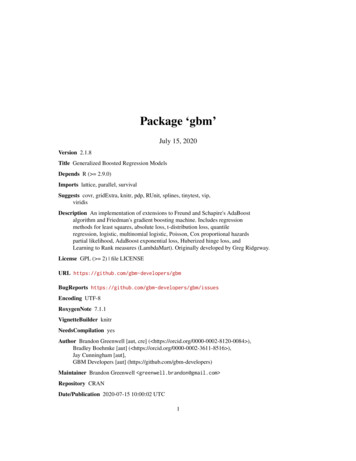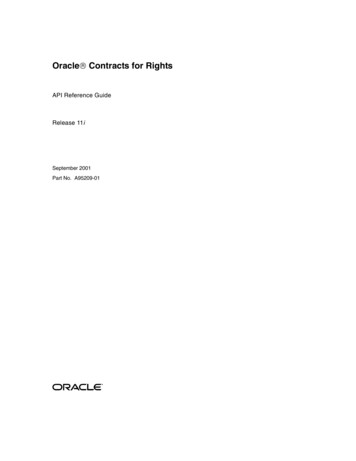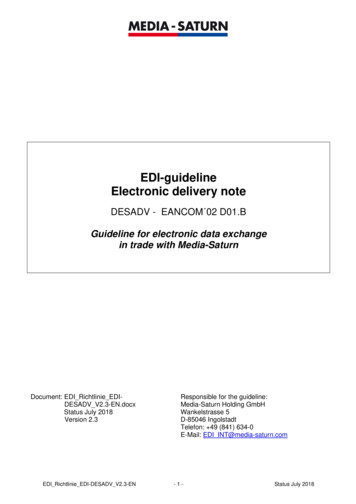
Transcription
Package ‘gbm’July 15, 2020Version 2.1.8Title Generalized Boosted Regression ModelsDepends R ( 2.9.0)Imports lattice, parallel, survivalSuggests covr, gridExtra, knitr, pdp, RUnit, splines, tinytest, vip,viridisDescription An implementation of extensions to Freund and Schapire's AdaBoostalgorithm and Friedman's gradient boosting machine. Includes regressionmethods for least squares, absolute loss, t-distribution loss, quantileregression, logistic, multinomial logistic, Poisson, Cox proportional hazardspartial likelihood, AdaBoost exponential loss, Huberized hinge loss, andLearning to Rank measures (LambdaMart). Originally developed by Greg Ridgeway.License GPL ( 2) file LICENSEURL https://github.com/gbm-developers/gbmBugReports ng UTF-8RoxygenNote 7.1.1VignetteBuilder knitrNeedsCompilation yesAuthor Brandon Greenwell [aut, cre] ( https://orcid.org/0000-0002-8120-0084 ),Bradley Boehmke [aut] ( https://orcid.org/0000-0002-3611-8516 ),Jay Cunningham [aut],GBM Developers [aut] (https://github.com/gbm-developers)Maintainer Brandon Greenwell greenwell.brandon@gmail.com Repository CRANDate/Publication 2020-07-15 10:00:02 UTC1
2gbm-packageR topics documented:gbm-package . . . .basehaz.gbm . . . . .calibrate.plot . . . .gbm . . . . . . . . .gbm.fit . . . . . . . .gbm.more . . . . . .gbm.object . . . . .gbm.perf . . . . . . .gbm.roc.area . . . .gbmCrossVal . . . .guessDist . . . . . .interact.gbm . . . . .plot.gbm . . . . . . .predict.gbm . . . . .pretty.gbm.tree . . .print.gbm . . . . . .quantile.rug . . . . .reconstructGBMdatarelative.influence . .summary.gbm . . . .test.gbm . . . . . . 33353638Generalized Boosted Regression Models (GBMs)DescriptionThis package implements extensions to Freund and Schapire’s AdaBoost algorithm and J. Friedman’s gradient boosting machine. Includes regression methods for least squares, absolute loss, logistic, Poisson, Cox proportional hazards partial likelihood, multinomial, t-distribution, AdaBoostexponential loss, Learning to Rank, and Huberized hinge loss.DetailsFurther information is available in vignette: browseVignettes(package "gbm")Author(s)Greg Ridgeway gregridgeway@gmail.com with contributions by Daniel Edwards, Brian Kriegler,Stefan Schroedl and Harry Southworth.
basehaz.gbm3ReferencesY. Freund and R.E. Schapire (1997) “A decision-theoretic generalization of on-line learning and anapplication to boosting,” Journal of Computer and System Sciences, 55(1):119-139.G. Ridgeway (1999). “The state of boosting,” Computing Science and Statistics 31:172-181.J.H. Friedman, T. Hastie, R. Tibshirani (2000). “Additive Logistic Regression: a Statistical View ofBoosting,” Annals of Statistics 28(2):337-374.J.H. Friedman (2001). “Greedy Function Approximation: A Gradient Boosting Machine,” Annalsof Statistics 29(5):1189-1232.J.H. Friedman (2002). “Stochastic Gradient Boosting,” Computational Statistics and Data Analysis38(4):367-378.The http://statweb.stanford.edu/ jhf/R-MART website.basehaz.gbmBaseline hazard functionDescriptionComputes the Breslow estimator of the baseline hazard function for a proportional hazard regressionmodel.Usagebasehaz.gbm(t, delta, f.x, t.eval NULL, smooth FALSE, cumulative TRUE)ArgumentstThe survival times.deltaThe censoring indicator.f.xThe predicted values of the regression model on the log hazard scale.t.evalValues at which the baseline hazard will be evaluated.smoothIf TRUE basehaz.gbm will smooth the estimated baseline hazard using Friedman’s super smoother supsmu.cumulativeIf TRUE the cumulative survival function will be computed.DetailsThe proportional hazard model assumes h(t x) lambda(t)*exp(f(x)). gbm can estimate the f(x) component via partial likelihood. After estimating f(x), basehaz.gbm can compute the a nonparametricestimate of lambda(t).ValueA vector of length equal to the length of t (or of length t.eval if t.eval is not NULL) containingthe baseline hazard evaluated at t (or at t.eval if t.eval is not NULL). If cumulative is set to TRUEthen the returned vector evaluates the cumulative hazard function at those values.
4calibrate.plotAuthor(s)Greg Ridgeway gregridgeway@gmail.com ReferencesN. Breslow (1972). "Discussion of ‘Regression Models and Life-Tables’ by D.R. Cox," Journal ofthe Royal Statistical Society, Series B, 34(2):216-217.N. Breslow (1974). "Covariance analysis of censored survival data," Biometrics 30:89-99.See Alsosurvfit, gbmcalibrate.plotCalibration plotDescriptionAn experimental diagnostic tool that plots the fitted values versus the actual average values. Currently only available when distribution "bernoulli".Usagecalibrate.plot(y,p,distribution "bernoulli",replace TRUE,line.par list(col "black"),shade.col "lightyellow",shade.density NULL,rug.par list(side 1),xlab "Predicted value",ylab "Observed average",xlim NULL,ylim NULL,knots NULL,df 6,.)ArgumentsyThe outcome 0-1 variable.pThe predictions estimating E(y x).
calibrate.plot5distributionThe loss function used in creating p. bernoulli and poisson are currently theonly special options. All others default to squared error assuming gaussian.replaceDetermines whether this plot will replace or overlay the current plot. replace FALSEis useful for comparing the calibration of several methods.line.parGraphics parameters for the line.shade.colColor for shading the 2 SE region. shade.col NA implies no 2 SE region.shade.densityThe density parameter for polygon.rug.parGraphics parameters passed to rug.xlabx-axis label corresponding to the predicted values.ylaby-axis label corresponding to the observed average.xlim, ylimx- and y-axis limits. If not specified te function will select limits.knots, dfThese parameters are passed directly to ns for constructing a natural splinesmoother for the calibration curve.Additional optional arguments to be passed onto plotDetailsUses natural splines to estimate E(y p). Well-calibrated predictions imply that E(y p) p. The plotalso includes a pointwise 95ValueNo return values.Author(s)Greg Ridgeway gregridgeway@gmail.com ReferencesJ.F. Yates (1982). "External correspondence: decomposition of the mean probability score," Organisational Behaviour and Human Performance 30:132-156.D.J. Spiegelhalter (1986). "Probabilistic Prediction in Patient Management and Clinical Trials,"Statistics in Medicine 5:421-433.Examples# Don't want R CMD check to think there is a dependency on rpart# so comment out the example#library(rpart)#data(kyphosis)#y - as.numeric(kyphosis Kyphosis)-1#x - kyphosis Age#glm1 - glm(y poly(x,2),family binomial)#p - predict(glm1,type "response")#calibrate.plot(y, p, xlim c(0,0.6), ylim c(0,0.6))
6gbmgbmGeneralized Boosted Regression Modeling (GBM)DescriptionFits generalized boosted regression models. For technical details, see the vignette: utils::browseVignettes("gbm").Usagegbm(formula formula(data),distribution "bernoulli",data list(),weights,var.monotone NULL,n.trees 100,interaction.depth 1,n.minobsinnode 10,shrinkage 0.1,bag.fraction 0.5,train.fraction 1,cv.folds 0,keep.data TRUE,verbose FALSE,class.stratify.cv NULL,n.cores NULL)ArgumentsformulaA symbolic description of the model to be fit. The formula may include an offsetterm (e.g. y offset(n) x). If keep.data FALSE in the initial call to gbm then itis the user’s responsibility to resupply the offset to gbm.more.distributionEither a character string specifying the name of the distribution to use or a listwith a component name specifying the distribution and any additional parameters needed. If not specified, gbm will try to guess: if the response has only2 unique values, bernoulli is assumed; otherwise, if the response is a factor,multinomial is assumed; otherwise, if the response has class "Surv", coxph isassumed; otherwise, gaussian is assumed.Currently available options are "gaussian" (squared error), "laplace" (absolute loss), "tdist" (t-distribution loss), "bernoulli" (logistic regression for0-1 outcomes), "huberized" (huberized hinge loss for 0-1 outcomes), classes),"adaboost" (the AdaBoost exponential loss for 0-1 outcomes), "poisson" (countoutcomes), "coxph" (right censored observations), "quantile", or "pairwise"(ranking measure using the LambdaMart algorithm).
gbm7dataweightsIf quantile regression is specified, distribution must be a list of the formlist(name "quantile",alpha 0.25) where alpha is the quantile to estimate. The current version’s quantile regression method does not handle nonconstant weights and will stop.If "tdist" is specified, the default degrees of freedom is 4 and this can be controlled by specifying distribution list(name "tdist",df DF) whereDF is your chosen degrees of freedom.If "pairwise" regression is specified, distribution must be a list of the formlist(name "pairwise",group .,metric .,max.rank .) (metric andmax.rank are optional, see below). group is a character vector with the columnnames of data that jointly indicate the group an instance belongs to (typicallya query in Information Retrieval applications). For training, only pairs of instances from the same group and with different target labels can be considered.metric is the IR measure to use, one oflist("conc") Fraction of concordant pairs; for binary labels, this is equivalentto the Area under the ROC Curve: Fraction of concordant pairs; for binary labels, this is equivalent to the Areaunder the ROC Curvelist("mrr") Mean reciprocal rank of the highest-ranked positive instance: Mean reciprocal rank of the highest-ranked positive instancelist("map") Mean average precision, a generalization of mrr to multiple positive instances: Mean average precision, a generalization of mrr to multiple positive instanceslist("ndcg:") Normalized discounted cumulative gain. The score is the weightedsum (DCG) of the user-supplied target values, weighted by log(rank 1),and normalized to the maximum achievable value. This is the default if theuser did not specify a metric.ndcg and conc allow arbitrary target values, while binary targets 0,1 are expected for map and mrr. For ndcg and mrr, a cut-off can be chosen using apositive integer parameter max.rank. If left unspecified, all ranks are taken intoaccount.Note that splitting of instances into training and validation sets follows groupboundaries and therefore only approximates the specified train.fraction ratio(the same applies to cross-validation folds). Internally, queries are randomlyshuffled before training, to avoid bias.Weights can be used in conjunction with pairwise metrics, however it is assumedthat they are constant for instances from the same group.For details and background on the algorithm, see e.g. Burges (2010).an optional data frame containing the variables in the model. By default the variables are taken from environment(formula), typically the environment fromwhich gbm is called. If keep.data TRUE in the initial call to gbm then gbm storesa copy with the object. If keep.data FALSE then subsequent calls to gbm.moremust resupply the same dataset. It becomes the user’s responsibility to resupplythe same data at this point.an optional vector of weights to be used in the fitting process. Must be positivebut do not need to be normalized. If keep.data FALSE in the initial call to gbmthen it is the user’s responsibility to resupply the weights to gbm.more.
8gbmvar.monotonean optional vector, the same length as the number of predictors, indicating whichvariables have a monotone increasing ( 1), decreasing (-1), or arbitrary (0) relationship with the outcome.n.treesInteger specifying the total number of trees to fit. This is equivalent to the number of iterations and the number of basis functions in the additive expansion.Default is 100.interaction.depthInteger specifying the maximum depth of each tree (i.e., the highest level ofvariable interactions allowed). A value of 1 implies an additive model, a valueof 2 implies a model with up to 2-way interactions, etc. Default is 1.n.minobsinnode Integer specifying the minimum number of observations in the terminal nodesof the trees. Note that this is the actual number of observations, not the totalweight.shrinkagea shrinkage parameter applied to each tree in the expansion. Also known asthe learning rate or step-size reduction; 0.001 to 0.1 usually work, but a smallerlearning rate typically requires more trees. Default is 0.1.bag.fractionthe fraction of the training set observations randomly selected to propose thenext tree in the expansion. This introduces randomnesses into the model fit. Ifbag.fraction 1 then running the same model twice will result in similar butdifferent fits. gbm uses the R random number generator so set.seed can ensurethat the model can be reconstructed. Preferably, the user can save the returnedgbm.object using save. Default is 0.5.train.fraction The first train.fraction * nrows(data) observations are used to fit the gbmand the remainder are used for computing out-of-sample estimates of the lossfunction.cv.foldsNumber of cross-validation folds to perform. If cv.folds 1 then gbm, in addition to the usual fit, will perform a cross-validation, calculate an estimate ofgeneralization error returned in cv.error.keep.dataa logical variable indicating whether to keep the data and an index of the datastored with the object. Keeping the data and index makes subsequent calls togbm.more faster at the cost of storing an extra copy of the dataset.verboseLogical indicating whether or not to print out progress and performance indicators (TRUE). If this option is left unspecified for gbm.more, then it uses verbosefrom object. Default is FALSE.class.stratify.cvLogical indicating whether or not the cross-validation should be stratified byclass. Defaults to TRUE for distribution "multinomial" and is only implemented for "multinomial" and "bernoulli". The purpose of stratifyingthe cross-validation is to help avoiding situations in which training sets do notcontain all classes.n.coresThe number of CPU cores to use. The cross-validation loop will attempt to senddifferent CV folds off to different cores. If n.cores is not specified by the user,it is guessed using the detectCores function in the parallel package. Notethat the documentation for detectCores makes clear that it is not failsafe andcould return a spurious number of available cores.
gbm9Detailsgbm.fit provides the link between R and the C gbm engine. gbm is a front-end to gbm.fitthat uses the familiar R modeling formulas. However, model.frame is very slow if there are manypredictor variables. For power-users with many variables use gbm.fit. For general practice gbm ispreferable.This package implements the generalized boosted modeling framework. Boosting is the processof iteratively adding basis functions in a greedy fashion so that each additional basis function further reduces the selected loss function. This implementation closely follows Friedman’s GradientBoosting Machine (Friedman, 2001).In addition to many of the features documented in the Gradient Boosting Machine, gbm offers additional features including the out-of-bag estimator for the optimal number of iterations, the ability tostore and manipulate the resulting gbm object, and a variety of other loss functions that had not previously had associated boosting algorithms, including the Cox partial likelihood for censored data,the poisson likelihood for count outcomes, and a gradient boosting implementation to minimize theAdaBoost exponential loss function.ValueA gbm.object object.Author(s)Greg Ridgeway gregridgeway@gmail.com Quantile regression code developed by Brian Kriegler bk@stat.ucla.edu t-distribution, and multinomial code developed by Harry Southworth and Daniel EdwardsPairwise code developed by Stefan Schroedl schroedl@a9.com ReferencesY. Freund and R.E. Schapire (1997) “A decision-theoretic generalization of on-line learning and anapplication to boosting,” Journal of Computer and System Sciences, 55(1):119-139.G. Ridgeway (1999). “The state of boosting,” Computing Science and Statistics 31:172-181.J.H. Friedman, T. Hastie, R. Tibshirani (2000). “Additive Logistic Regression: a Statistical View ofBoosting,” Annals of Statistics 28(2):337-374.J.H. Friedman (2001). “Greedy Function Approximation: A Gradient Boosting Machine,” Annalsof Statistics 29(5):1189-1232.J.H. Friedman (2002). “Stochastic Gradient Boosting,” Computational Statistics and Data Analysis38(4):367-378.B. Kriegler (2007). Cost-Sensitive Stochastic Gradient Boosting Within a Quantitative RegressionFramework. Ph.D. Dissertation. University of California at Los Angeles, Los Angeles, CA, USA.Advisor(s) Richard A. Berk. urlhttps://dl.acm.org/citation.cfm?id 1354603.C. Burges (2010). “From RankNet to LambdaRank to LambdaMART: An Overview,” MicrosoftResearch Technical Report MSR-TR-2010-82.
10gbmSee Alsogbm.object, gbm.perf, plot.gbm, predict.gbm, summary.gbm, and pretty.gbm.tree.Examples## A least squares regression example## Simulate dataset.seed(101) # for reproducibilityN - 1000X1 - runif(N)X2 - 2 * runif(N)X3 - ordered(sample(letters[1:4], N, replace TRUE), levels letters[4:1])X4 - factor(sample(letters[1:6], N, replace TRUE))X5 - factor(sample(letters[1:3], N, replace TRUE))X6 - 3 * runif(N)mu - c(-1, 0, 1, 2)[as.numeric(X3)]SNR - 10 # signal-to-noise ratioY - X1 1.5 2 * (X2 0.5) musigma - sqrt(var(Y) / SNR)Y - Y rnorm(N, 0, sigma)X1[sample(1:N,size 500)] - NA # introduce some missing valuesX4[sample(1:N,size 300)] - NA # introduce some missing valuesdata - data.frame(Y, X1, X2, X3, X4, X5, X6)# Fit a GBMset.seed(102) # for reproducibilitygbm1 - gbm(Y ., data data, var.monotone c(0, 0, 0, 0, 0, 0),distribution "gaussian", n.trees 100, shrinkage 0.1,interaction.depth 3, bag.fraction 0.5, train.fraction 0.5,n.minobsinnode 10, cv.folds 5, keep.data TRUE,verbose FALSE, n.cores 1)# Check performance using the out-of-bag (OOB) error; the OOB error typically# underestimates the optimal number of iterationsbest.iter - gbm.perf(gbm1, method "OOB")print(best.iter)# Check performance using the 50% heldout test setbest.iter - gbm.perf(gbm1, method "test")print(best.iter)# Check performance using 5-fold cross-validationbest.iter - gbm.perf(gbm1, method "cv")print(best.iter)# Plot relative influence of each variablepar(mfrow c(1, 2))summary(gbm1, n.trees 1)# using first treesummary(gbm1, n.trees best.iter) # using estimated best number of trees
gbm.fit11# Compactly print the first and last trees for curiosityprint(pretty.gbm.tree(gbm1, i.tree 1))print(pretty.gbm.tree(gbm1, i.tree gbm1 n.trees))# Simulate new dataset.seed(103) # for reproducibilityN - 1000X1 - runif(N)X2 - 2 * runif(N)X3 - ordered(sample(letters[1:4], N, replace TRUE))X4 - factor(sample(letters[1:6], N, replace TRUE))X5 - factor(sample(letters[1:3], N, replace TRUE))X6 - 3 * runif(N)mu - c(-1, 0, 1, 2)[as.numeric(X3)]Y - X1 1.5 2 * (X2 0.5) mu rnorm(N, 0, sigma)data2 - data.frame(Y, X1, X2, X3, X4, X5, X6)# Predict on the new data using the "best" number of trees; by default,# predictions will be on the link scaleYhat - predict(gbm1, newdata data2, n.trees best.iter, type "link")# least squares errorprint(sum((data2 Y - Yhat) 2))# Construct univariate partial dependence plotsplot(gbm1, i.var 1, n.trees best.iter)plot(gbm1, i.var 2, n.trees best.iter)plot(gbm1, i.var "X3", n.trees best.iter) # can use index or name# Construct bivariate partial dependence plotsplot(gbm1, i.var 1:2, n.trees best.iter)plot(gbm1, i.var c("X2", "X3"), n.trees best.iter)plot(gbm1, i.var 3:4, n.trees best.iter)# Construct trivariate partial dependence plotsplot(gbm1, i.var c(1, 2, 6), n.trees best.iter,continuous.resolution 20)plot(gbm1, i.var 1:3, n.trees best.iter)plot(gbm1, i.var 2:4, n.trees best.iter)plot(gbm1, i.var 3:5, n.trees best.iter)# Add more (i.e., 100) boosting iterations to the ensemblegbm2 - gbm.more(gbm1, n.new.trees 100, verbose FALSE)gbm.fitGeneralized Boosted Regression Modeling (GBM)
12gbm.fitDescriptionWorkhorse function providing the link between R and the C gbm engine. gbm is a front-endto gbm.fit that uses the familiar R modeling formulas. However, model.frame is very slow ifthere are many predictor variables. For power-users with many variables use gbm.fit. For generalpractice gbm is preferable.Usagegbm.fit(x,y,offset NULL,misc NULL,distribution "bernoulli",w NULL,var.monotone NULL,n.trees 100,interaction.depth 1,n.minobsinnode 10,shrinkage 0.001,bag.fraction 0.5,nTrain NULL,train.fraction NULL,keep.data TRUE,verbose TRUE,var.names NULL,response.name "y",group NULL)ArgumentsxA data frame or matrix containing the predictor variables. The number of rowsin x must be the same as the length of y.yA vector of outcomes. The number of rows in x must be the same as the lengthof y.offsetA vector of offset values.miscAn R object that is simply passed on to the gbm engine. It can be used foradditional data for the specific distribution. Currently it is only used for passingthe censoring indicator for the Cox proportional hazards model.distributionEither a character string specifying the name of the distribution to use or a listwith a component name specifying the distribution and any additional parameters needed. If not specified, gbm will try to guess: if the response has only2 unique values, bernoulli is assumed; otherwise, if the response is a factor,multinomial is assumed; otherwise, if the response has class "Surv", coxph isassumed; otherwise, gaussian is assumed.
gbm.fit13Currently available options are "gaussian" (squared error), "laplace" (absolute loss), "tdist" (t-distribution loss), "bernoulli" (logistic regression for0-1 outcomes), "huberized" (huberized hinge loss for 0-1 outcomes), classes),"adaboost" (the AdaBoost exponential loss for 0-1 outcomes), "poisson" (countoutcomes), "coxph" (right censored observations), "quantile", or "pairwise"(ranking measure using the LambdaMart algorithm).If quantile regression is specified, distribution must be a list of the formlist(name "quantile",alpha 0.25) where alpha is the quantile to estimate. The current version’s quantile regression method does not handle nonconstant weights and will stop.If "tdist" is specified, the default degrees of freedom is 4 and this can be controlled by specifying distribution list(name "tdist",df DF) whereDF is your chosen degrees of freedom.If "pairwise" regression is specified, distribution must be a list of the formlist(name "pairwise",group .,metric .,max.rank .) (metric andmax.rank are optional, see below). group is a character vector with the columnnames of data that jointly indicate the group an instance belongs to (typicallya query in Information Retrieval applications). For training, only pairs of instances from the same group and with different target labels can be considered.metric is the IR measure to use, one oflist("conc") Fraction of concordant pairs; for binary labels, this is equivalentto the Area under the ROC Curve: Fraction of concordant pairs; for binary labels, this is equivalent to the Areaunder the ROC Curvelist("mrr") Mean reciprocal rank of the highest-ranked positive instance: Mean reciprocal rank of the highest-ranked positive instancelist("map") Mean average precision, a generalization of mrr to multiple positive instances: Mean average precision, a generalization of mrr to multiple positive instanceslist("ndcg:") Normalized discounted cumulative gain. The score is the weightedsum (DCG) of the user-supplied target values, weighted by log(rank 1),and normalized to the maximum achievable value. This is the default if theuser did not specify a metric.ndcg and conc allow arbitrary target values, while binary targets 0,1 are expected for map and mrr. For ndcg and mrr, a cut-off can be chosen using apositive integer parameter max.rank. If left unspecified, all ranks are taken intoaccount.Note that splitting of instances into training and validation sets follows groupboundaries and therefore only approximates the specified train.fraction ratio(the same applies to cross-validation folds). Internally, queries are randomlyshuffled before training, to avoid bias.Weights can be used in conjunction with pairwise metrics, however it is assumedthat they are constant for instances from the same group.For details and background on the algorithm, see e.g. Burges (2010).wA vector of weights of the same length as the y.
14gbm.fitvar.monotonean optional vector, the same length as the number of predictors, indicating whichvariables have a monotone increasing ( 1), decreasing (-1), or arbitrary (0) relationship with the outcome.n.treesthe total number of trees to fit. This is equivalent to the number of iterations andthe number of basis functions in the additive expansion.interaction.depthThe maximum depth of variable interactions. A value of 1 implies an additivemodel, a value of 2 implies a model with up to 2-way interactions, etc. Defaultis 1.n.minobsinnode Integer specifying the minimum number of observations in the trees terminalnodes. Note that this is the actual number of observations not the total weight.shrinkageThe shrinkage parameter applied to each tree in the expansion. Also known asthe learning rate or step-size reduction; 0.001 to 0.1 usually work, but a smallerlearning rate typically requires more trees. Default is 0.1.bag.fractionThe fraction of the training set observations randomly selected to propose thenext tree in the expansion. This introduces randomnesses into the model fit. Ifbag.fraction 1 then running the same model twice will result in similar butdifferent fits. gbm uses the R random number generator so set.seed can ensurethat the model can be reconstructed. Preferably, the user can save the returnedgbm.object using save. Default is 0.5.nTrainAn integer representing the number of cases on which to train. This is thepreferred way of specification for gbm.fit; The option train.fraction ingbm.fit is deprecated and only maintained for backward compatibility. Thesetwo parameters are mutually exclusive. If both are unspecified, all data is usedfor training.train.fraction The first train.fraction * nrows(data) observations are used to fit the gbmand the remainder are used for computing out-of-sample estimates of the lossfunction.keep.dataLogical indicating whether or not to keep the data and an index of the data storedwith the object. Keeping the data and index makes subsequent calls to gbm.morefaster at the cost of storing an extra copy of the dataset.verboseLogical indicating whether or not to print out progress and performance indicators (TRUE). If this option is left unspecified for gbm.more, then it uses verbosefrom object. Default is FALSE.var.namesVector of strings of length equal to the number of columns of x containing thenames of the predictor variables.response.nameCharacter string label for the response variable.groupThe group to use when distribution "pairwise".DetailsThis package implements the generalized boosted modeling framework. Boosting is the processof iteratively adding basis functions in a greedy fashion so that each additional basis function further reduces the selected loss function. This implementation closely follows Friedman’s GradientBoosting Machine (Friedman, 2001).
gbm.fit15In addition to many of the features documented in the Gradient Boosting Machine, gbm offers additional features including the out-of-bag estimator for the optimal number of iterations, the ability tostore and manipulate the resulting gbm object, and a variety of other loss functions that had not previously had associated boosting algorithms, including the Cox partial likelihood for censored data,the poisson likelihood for count outcomes, and a gradient boosting implementation to minimize theAdaBoost exponential loss function.ValueA gbm.object object.Author(s)Greg Ridgeway gregridgeway@gmail.com Quantile regression code developed by Brian Kriegler bk@stat.ucla.edu t-distribution, and multinomial code developed by Harry Southworth and Daniel EdwardsPairwise code developed by Stefan Schroedl schroedl@a9.com ReferencesY. Freund and R.E. Schapire (1997) “A decision-theoretic generalization of on-line learning and anapplication to boosting,” Journal of Computer and System Sciences, 55(1):119-139.G. Ridgeway (1999). “The state of boosting,” Computing Science and Statistics 31:172-181.J.H. Friedman, T. Hastie, R. Tibshirani (2000). “Additive Logistic Regression: a Statistical View ofBoosting,” Annals of Statistics 28(2):337-374.J.H. Friedman (2001). “Greedy Function Approximation: A Gradient Boosting Machine,” Annalsof Statistics 29(5):1189-1232.J.H. Friedman (2002). “Stochastic Gradient Boosting,” Computational Statistics and Data Analysis38(4):367-378.B. Kriegler (2007). Cost-Sensitive Stochastic Gradient Boosting Within a Quantitative RegressionFramework. Ph.D. Dissertation. University of California at Los Angeles, Los Angeles, CA, USA.Advisor(s) Richard A
which gbm is called. If keep.data TRUE in the initial call to gbm then gbm stores a copy with the object. If keep.data FALSE then subsequent calls to gbm.more must resupply the same dataset. It becomes the user's responsibility to resupply the same data at this point. weights an optional vector of weights to be used in the fitting process.










